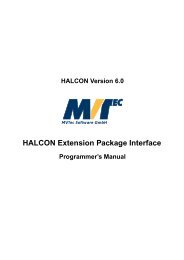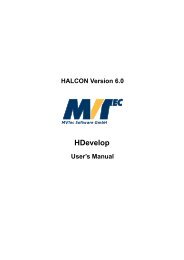HALCON/COM User's Manual
HALCON/COM User's Manual
HALCON/COM User's Manual
Create successful ePaper yourself
Turn your PDF publications into a flip-book with our unique Google optimized e-Paper software.
1.2. <strong>HALCON</strong> AND <strong>COM</strong> 3<br />
re-defined in the outer component. In contrast to this, the interface(s) of an aggregated component<br />
are merged with the interfaces of the aggregating one thus automatically making their<br />
methods visible to the outside. The object oriented feature of polymorphism is also achieved<br />
through interfaces: different <strong>COM</strong> classes exposing the same interface can be understood as<br />
showing polymorphic behaviour, as they act differently responding to the same methods.<br />
1.1.4 Early and Late Binding<br />
Binding is the process of resolving the call adresses of a component’s exposed methods. This<br />
can be done at compilation time (early binding)oratruntime(late binding). Thus when using<br />
a component a programmer can take a specification of the contained methods and integrate it<br />
directly into the application. Therefore, the specification must be available in a format that fits<br />
the used programming language (e.g. when using C++ as client language one would typically<br />
include the header-files containing the method declarations). Otherwise the programmer could<br />
make the methods being bound at runtime — then no language-dependent information is needed<br />
for compiling and the calling mechanism is totally different. Again we will not go into details<br />
and thus only point out the main aspect that runtime-bound methods calls are somewhat slower<br />
than their early-bound counterparts. The <strong>HALCON</strong>/<strong>COM</strong> interface supports both early and late<br />
binding so that special needs of different applications can be satisfied.<br />
1.2 <strong>HALCON</strong> and <strong>COM</strong><br />
1.2.1 Advantages<br />
How can the user of <strong>HALCON</strong> profit from a <strong>COM</strong> interface The main advantage is that with<br />
a <strong>COM</strong> interface the powerfull image processing features of <strong>HALCON</strong> can be used by a wide<br />
range of applications and development tools so that its usage is no longer restricted to C and<br />
C++. The world of Visual Basic, Delphi and other tools stands open for the development of<br />
<strong>HALCON</strong> applications. Beside this, another important advantage of a <strong>COM</strong> interface lies in<br />
the widespread standard <strong>HALCON</strong> is joining with it: nearly any piece of software related to<br />
Windows is also related to <strong>COM</strong>. This will not change in the near future and upcoming new development<br />
tools will be firmly bound to <strong>COM</strong> anyway. Further versions of the <strong>HALCON</strong>/<strong>COM</strong><br />
interface might also support <strong>COM</strong>’s ability to enable multi-client, multi-threaded application<br />
development with method calls across process and machine boundaries.<br />
1.2.2 Disadvantages<br />
Of course <strong>COM</strong> can also show some disadvantages and using <strong>HALCON</strong> in a component-based<br />
way can be rather tricky depending on the language and tool one is using for development. For<br />
example it is really easy to use software components with Visual Basic, but this is not necessarily<br />
the case when considering VisualC++ — here the “classic” <strong>HALCON</strong>/C++ interface is<br />
far more convenient. As said before, <strong>COM</strong> shows some other powerful features like options<br />
for distributed computing that may be supported in future <strong>HALCON</strong> releases. Then the HAL-<br />
CON/<strong>COM</strong> interface should be a big step ahead the other language interfaces.<br />
<strong>HALCON</strong> 6.0
















